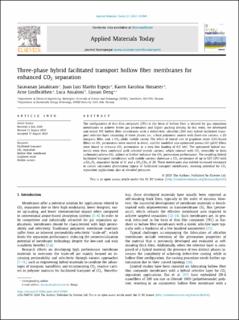| dc.contributor.author | Janakiram, Saravanan | |
| dc.contributor.author | Marin Espejo, Juan Luis | |
| dc.contributor.author | Høisæter, Karen Karolina | |
| dc.contributor.author | Lindbråthen, Arne | |
| dc.contributor.author | Ansaloni, Luca | |
| dc.contributor.author | Deng, Liyuan | |
| dc.date.accessioned | 2020-09-07T08:31:06Z | |
| dc.date.available | 2020-09-07T08:31:06Z | |
| dc.date.created | 2020-08-23T20:12:43Z | |
| dc.date.issued | 2020 | |
| dc.identifier.citation | Applied Materials Today. 2020, 21 | en_US |
| dc.identifier.issn | 2352-9407 | |
| dc.identifier.uri | https://hdl.handle.net/11250/2676566 | |
| dc.description.abstract | The configuration of thin film composite (TFC) in the form of hollow fiber is desired for gas separation membranes to achieve better gas permeation and higher packing density. In this work, we developed and tested TFC hollow fiber membranes with a defect-free, ultrathin (200 nm) hybrid facilitated transport selective layer consisting of three phases, i.e., a host polymeric matrix with fixed-site carriers, a 2D inorganic filler, and, a CO2-philic mobile carrier. The effect of lateral size of graphene oxide (GO)-based fillers on CO2 permeation were studied in detail, and the modified size-optimized porous GO (pGO) fillers were found to enhance CO2 permeation at a very low loading of 0.2 wt%. The optimized hybrid materials were then combined with selected mobile carriers, which interact with CO2 reversibly to form carbonate/carbene-CO2 adduct to further enhance the CO2 permeation performance. The resulting hybrid facilitated transport membranes with mobile carriers showcase a CO2 permeance of up to 825 GPU with a CO2/N2 separation factor of 31 and a CO2/CH4 of 20. These membranes also exhibit increased resistance to carrier saturation phenomena typical of facilitated transport membranes, showing potential for CO2 separation applications also at elevated pressures. | en_US |
| dc.language.iso | eng | en_US |
| dc.publisher | Elsevier | en_US |
| dc.rights | Navngivelse 4.0 Internasjonal | * |
| dc.rights.uri | http://creativecommons.org/licenses/by/4.0/deed.no | * |
| dc.title | Three-phase Hybrid Facilitated Transport Hollow Fiber Membranes for Enhanced CO2 Separation | en_US |
| dc.type | Peer reviewed | en_US |
| dc.type | Journal article | en_US |
| dc.description.version | publishedVersion | en_US |
| dc.source.volume | 21 | en_US |
| dc.source.journal | Applied Materials Today | en_US |
| dc.identifier.doi | https://doi.org/10.1016/j.apmt.2020.100801 | |
| dc.identifier.cristin | 1824678 | |
| dc.relation.project | Norges forskningsråd: 294533 | en_US |
| dc.description.localcode | This is an open access article distributed under the terms of the Creative Commons CC-BY license, which permits unrestricted use, distribution, and reproduction in any medium, provided the original work is properly cited. You are not required to obtain permission to reuse this article. | en_US |
| cristin.ispublished | true | |
| cristin.fulltext | original | |
| cristin.qualitycode | 1 | |

